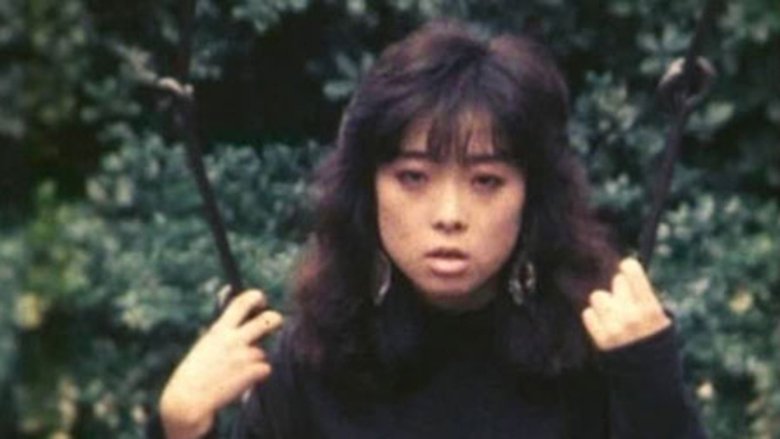Director: Shozin Fukui
Cast: Chiemi Endô as Gerorisuto
 Gerorisuto is merely a fragment, and should be treated as such,
part of the rewarding (and sometimes neglected) side of following an artistic
creator through all their tiniest notes as much as their biggest works,
creating a single work as a whole when combined as well as separately. It is
difficult at times when a director is prolific or when even know filmmakers
have work that is difficult to see, but in Gerorisuto's favour was that it was
an extra for an American DVD release of Rubber's
Lover (1996) and available.
Gerorisuto is merely a fragment, and should be treated as such,
part of the rewarding (and sometimes neglected) side of following an artistic
creator through all their tiniest notes as much as their biggest works,
creating a single work as a whole when combined as well as separately. It is
difficult at times when a director is prolific or when even know filmmakers
have work that is difficult to see, but in Gerorisuto's favour was that it was
an extra for an American DVD release of Rubber's
Lover (1996) and available.
The short begins with a young
woman who is happy to be chased by the camera. She is energetic, in the prime
of her life, wandering the Japanese subway cars as if the camera is gazing at
her and her to it as lovers.
Things turn sour in a scene where
she starts vomiting on her knees outside. Vomit happens in Shozin Fukui's films a bit, and is as here usually a sign of a
significant change in events and in a character's state of mind.
The film takes a sour turn as she
feels threatened now by the camera, on the same subway train fleeing from it
and even cowering in the corner in its gaze as it looms over her. This is not a
slasher film however with a killer's POV (point of view) which leads to a kill,
and the subway is packed with bystanders. Instead, you can make a comparison to
Samuel Beckett's Film (1965). The Irish playright and author only entered cinema
directly once, penning the script for a one-off avant-garde short in which an
older Buster Keaton was cast but you
only see his fact in at the end. The point was, obscuring his face to all, that
the context leads to him hiding from being perceived, including by the camera
itself which stalked him at points in the film.
Where this differs is when you
get to the denouement, effectively a public art performance at night in an
urban entertainment district, where she goes to buy an ice cream only to let it
fall to the floor as she finally snaps. It is a waste of a good ice cream, but
at the point the camera, close up to her, is closer to an ex-partner in a
relationship stalking her now than the camera of before. When she snaps, now it
is not against the camera, but the large crowd of bystanders she charges
through until eventually she starts shouting at them all in the middle of the
street.
Fukui's career would lead to him, a few years later, on the
production of Shinya Tsukamoto's Tetsuo: The Iron Man (1989). Tsukamoto before put on theatre pieces, and
befittingly Shozin Fukui would explore on performing in crowds who are not part
of the production for here and later 964
Pinocchio (1991), where famously (in an incredible set piece in Japanese
cult cinema) the lead actor is dragging a pyramid on a chain at full pelt down
crowded streets of a Japanese metropolis, the crowds parting like the Red Sea
as a man in white face makeup and dishevelled clothes drags a giant object like
a conceptual piece at fast speed between them.
Here, the lead actress starts
screaming at the crowd, even harassing a fresh faced salaryman, but members of
it actually find this amusing to witness. Even more isolated from the world,
our protagonist is left in this destructive state. As a fragment, closer to a
memory than a story, we can only ask what happened to her, not able to see where
she would be.
Abstract Spectrum: Grotesque
Abstract Rating (High/Medium/Low/None): None



No comments:
Post a Comment